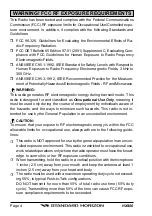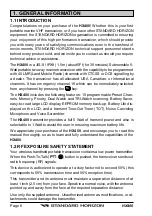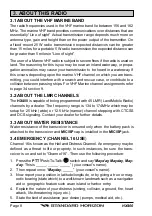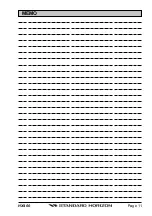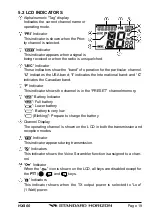
Page 9
HX400
6. Report the number of persons aboard and condition of any injured.
7. Estimate the present seaworthiness and condition of your vessel.
8. Give your vessel’s description: length, design (power or sail), color and other
distinguishing marks. The total transmission should not exceed 1 minute.
9. End the message by saying “
OVER
”. Release the
PTT
(
) switch and
listen.
10. If there is no answer, repeat the above procedure. If there is still no re-
sponse, try another channel.
3.5 CALLING ANOTHER VESSEL
(
CHANNEL 16 OR 9
)
Channel 16 may be used for initial contact (hailing) with another vessel.
However, its most important use is for emergency messages. This channel
must be monitored at all times except when actually using another channel.
It is monitored by the U.S. and Canadian Coast Guards and by other vessels.
Use of channel 16 for hailing must be limited to initial contact only. Calling
should not exceed 30 seconds, but may be repeated 3 times at 2-minute inter-
vals. In areas of heavy radio traffic, congestion on channel 16 resulting from its
use as a hailing channel can be reduced significantly in U.S. waters by using
Channel 9 as the initial contact (hailing) channel for non-emergency communi-
cations. Also hailing on channel 9, the calling time should not exceed 30 sec-
onds but may be repeated 3 times at 2-minute intervals.
Prior to making contact with another vessel, refer to the channel charts in this
manual, and select an appropriate channel for communications after initial
contact. For example, Channels 68 and 69 of the U.S. VHF Charts are some of
the channels available to non-commercial (recreational) boaters. Monitor your
desired channel in advance to make sure you will not be interrupting other
traffic, and then go back to either channel 16 or 9 for your initial contact.
When the hailing channel (16 or 9) is clear, state the name of the other vessel
you wish to call and then “
this is
” followed by the name of your vessel and
your Station License (Call Sign). When the other vessel returns your call, im-
mediately request another channel by saying “
go to
”, the number of the other
channel, and “
over
”. Then switch to the new channel. When the new channel
is not busy, call the other vessel.
After a transmission, say “
over
”, and release the
PTT
(Push-To-Talk:
) switch.
When all communication with the other vessel is completed, end the last trans-
mission by stating your Call Sign and the word “
out
”. Note that it is not neces-
sary to state your Call Sign with each transmission, only at the beginning and
end of the contact.
Remember to return to Channel 16 when not using another channel.
Содержание HX400
Страница 1: ...Page 1 HX400 HX400 VHF FM Marine Transceiver Owner s Manual ...
Страница 11: ...Page 11 HX400 MEMO ...
Страница 31: ...Page 31 HX400 MEMO ...
Страница 45: ...Page 45 HX400 MEMO ...
Страница 46: ...HX400 Page 46 MEMO ...




